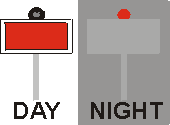Signals below
are used by infrastructure service teams. Usually the
signals are set during the track repairs or
accidental closings.
STOP
SIGNALS
|
 |
DO 'TRACK CLOSING SIGNAL AHEAD'
Handy
warning shield is much smaller than normal
mechanical forewarning signal, and is set without
W1 sign. DO signal means the track closing signal
D1 is set ahead. Details about D-group signalling
(distances, places, track sides) are explained in
E1-Rules.
|
 |
D1 'TRACK CLOSED'
Handy
shield is set on the track (between the rails at
station area) and means S1 - 'stop' signal. This
signal must be placed at least 50 m before the
protected point and usually is concerned with
following situations:
- track
damages and following them track closures
and similar situation when track
conditions let pass the track with speed
less than 10 km/h,
- the
train is stopped on route and needs to be
protected,
- S1
signal cannot be reflected on the
semaphore,
- Z-type
signal is blocked at 'passing allowed'
position,
- the
semaphore is broken down, stolen,
damaged, etc.,
- track
closure (or its fragment) within station
area,
- protection
of heavy track-repair stock left on side
tracks (together with derail closing).
|
NON-PERMAMENT
SPEED LIMIT SIGNALS
|
 |
D6 'NON-PERMAMENT SPEED LIMIT
IN BRAKE DISTANCE'
Handy
triangle-shaped sign (on tall or small pole) with
orange light (used during the night, together
with triangle illumination). The signal means
non-permament speed limit (in tens of the number
written within the triangle, here - 30 km/h) is
in brake distance (the limit borders are set by
W14 signs). Details about D-group signalling
(distances, places, track sides) are explained in
E1-Rules.
|
|
|



